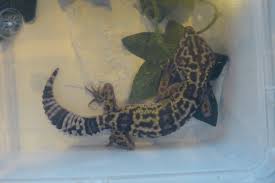GECKO TURKISH LEOPARD (Eublepharis turcmenicus)
$100.00
Full Description
Here’s a comprehensive care guide for the Turkish Leopard Gecko, which typically refers to Eublepharis angramainyu or sometimes Eublepharis macularius from Turkey’s eastern range. This guide is based on Eublepharis angramainyu, often dubbed the Iranian or Turkish Fat-Tailed Gecko, which is larger and more robust than the common Leopard Gecko.
Turkish Leopard Gecko (Eublepharis angramainyu) Care Guide
Common Name:
-
Turkish Leopard Gecko
-
Iranian Fat-Tailed Gecko
-
Angramainyu Gecko
Scientific Name:
-
Eublepharis angramainyu
Size & Lifespan
-
Adult Size: 8–11 inches (20–28 cm)
-
Lifespan: 10–20 years in captivity with proper care
️ Natural Habitat
-
Arid and semi-arid regions of eastern Turkey, Iran, Iraq, and Syria
-
Rocky terrain, scrublands, and dry forests
-
Nocturnal and terrestrial (ground-dwelling)
Enclosure Setup
Enclosure Size
| Age | Minimum Size |
|---|---|
| Juvenile | 20-gallon long tank |
| Adult | 40-gallon breeder or larger |
Substrate
-
Best Options:
-
Excavator clay with sand mix
-
Bioactive desert substrate
-
Paper towel (for quarantine or hatchlings)
-
-
Avoid: Calcium sand, loose sand (impaction risk)
Hides (at least 3):
-
Warm Hide – placed on the heat side
-
Cool Hide – for temperature regulation
-
Moist Hide – with sphagnum moss to aid shedding
Decor
-
Rocks, logs, branches for enrichment
-
Climbing is limited, but they enjoy terrain variety
️ Temperature & Humidity
| Zone | Temp (°F) | Temp (°C) |
|---|---|---|
| Warm Side | 88–92°F | 31–33°C |
| Cool Side | 75–80°F | 24–27°C |
| Nighttime | 70–75°F | 21–24°C |
-
Humidity: 40–60% (brief spikes up to 70% are okay)
-
Provide a humid hide at all times
Heating
-
Under Tank Heater (UTH) or radiant heat panel
-
Use a thermostat to regulate temperatures
Lighting
-
Not strictly necessary, but a low-intensity UVB (2.0–5.0) can be beneficial
-
Provide a natural day/night cycle (12 hours on/off)
️ Diet & Feeding
Insectivorous Diet
-
Staples:
-
Crickets
-
Dubia roaches
-
Superworms (occasionally)
-
-
Occasional Treats:
-
Silkworms, hornworms, waxworms (high fat)
-
Supplementation
-
Calcium with D3: 2x/week
-
Calcium without D3: Available at all times
-
Multivitamin: 1x/week
Feeding Schedule
| Age | Frequency |
|---|---|
| Juvenile | Daily |
| Adult | Every 2–3 days |
Cleaning & Maintenance
-
Spot clean daily
-
Full clean monthly (or more often if needed)
-
Replace substrate every 3–6 months (for non-bioactive)
⚕️ Health & Behavior
Common Health Issues:
-
Impaction (from ingesting substrate or prey too large)
-
Metabolic bone disease (from poor calcium/D3)
-
Respiratory infections (due to high humidity or low temps)
Signs of a Healthy Gecko:
-
Bright eyes
-
Strong appetite
-
Full tail (fat storage)
-
Active at night
Temperament:
-
Calm and slow-moving
-
Can be shy; needs time to acclimate
-
Handle gently, no grabbing by the tail
Breeding (Advanced)
-
Sexing: Males have hemipenal bulges and pre-anal pores
-
Breeding Season: Spring to early summer
-
Clutch Size: 1–2 eggs
-
Incubation Temp: 82–88°F (gender-influenced)

